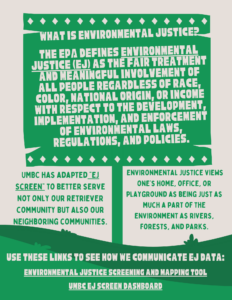What is Environmental Justice?
The environmental justice movement traces its origins back to the 1980s where it grew in response to the disproportionate environmental burdens communities of color and low-income communities bear including pollution, industrial production, and processing facilities, landfills, and power plants. Simultaneously these communities often have fewer environmental benefits like parks, gardens, and green spaces, while facing inadequate health care, access to healthy food, less political power. The Environmental Justice Movement leverages the gains and protections from the American Civil Rights movement and recognizing discrimination also happens in terms of environmental benefits and burdens.
Measuring Environmental Justice
EJSCREEN is an environmental justice mapping and screening tool that provides EPA with a nationally consistent dataset and approach for combining environmental and demographic indicators. EJSCREEN users choose a geographic area; the tool then provides demographic and environmental information for that area. All of the EJSCREEN indicators are publicly available data. EJSCREEN simply provides a way to display this information and includes a method for combining environmental and demographic indicators into EJ indexes.
Links to UMBC Data in above flyer:
